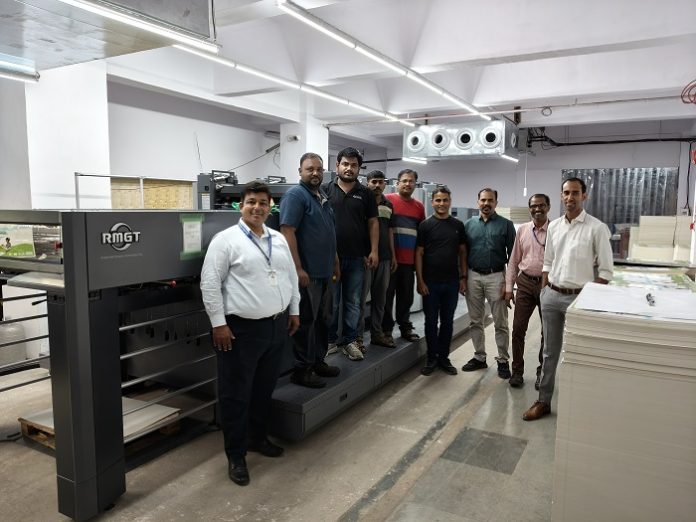Navi Mumbai-based educational book printer Quarterfold Printabilities has added an RMGT 920 4-color sheetfed offset press to its operations at Taloja, marking a shift in its production strategy to meet the evolving demand in educational publishing. The new press, installed in the second half of April, supports a flexible production setup across the company’s three units.
Milton Everjoy, head of operations, explained that a growing requirement for shorter turnaround times and varied formats drove the decision. “The RMGT 920 fits into our current workflow. We needed a press that could handle a wide range of book sizes without compromising on throughput. This helps us respond to dynamic scheduling and maintain delivery timelines. The fact that Provin is the supplier was also a factor, due to their support system. We should be able to do 2-2.5 million impressions a month,” he said.
Quarterfold’s Taloja footprint encompasses three distinct production units, each operating independently from raw material intake to final dispatch. Every unit has its own prepress, press, and post-press infrastructure. Quarterfold’s existing setup includes more than two dozen web towers and folders, three Komori sheetfed presses, and the new RMGT 920. According to Everjoy, this layout eliminates delays caused by inter-unit dependencies and allows the company to serve multiple client deadlines in parallel. In addition to its three production units, the company has a 65,000 square foot warehouse.
The company has seen a gradual shift in its market mix. While exports remain a big focus, domestic demand is now on the rise. Sameer Kazi, director – sales and operations, said that the domestic market currently contributes around 30-35% of the total business. “We are moving toward a 50:50 split between exports and domestic orders. India is becoming more relevant as educational publishing diversifies,” he said.
The changes in customer demand are also altering how production is planned. Kazi said that earlier, publishers would place large bulk orders, often for full truckloads of books. Now, the company gets requests for kits—sorted packs of books delivered directly to schools or regional hubs. These jobs are often smaller in quantity and require greater precision in packaging.
Even long-run jobs on web presses are shrinking. “We regularly see jobs with print runs of 5,000 or fewer. Publishers want to avoid carrying extra stock and are relying more on short, quick print cycles. That’s where our planning system and the flexibility of our equipment come into play,” said Kazi.
The three plants together handle more than 2,500 metric tons of paper per month during peak season and produce six to seven million books monthly. The new press is being used to print on grades ranging from 190 to 350 gsm.
Quarterfold’s decision-making is increasingly data-driven. Kazi said all investment planning is based on internal MIS reports and recurring job patterns.
On the operational side, the company has implemented a centralized reporting system to monitor efficiency across all three units. The system tracks utilities, material consumption, machine usage, and dispatch status. “This gives us real-time visibility and helps during client audits. We also use it for internal cost control and benchmarking,” Everjoy said.
In terms of content, the company is seeing new emerging formats. Publishers are experimenting with stickers, tear-outs, and interactive pages, influenced by trends in other regions. “We are already handling projects that require these elements. India is gradually moving in that direction, especially for private publishers who want to differentiate their content,” said Kazi.
Exploring new geographies
The company has expanded into trade and activity books, particularly for international markets such as Mexico, Spain, and the United States. Participation in global book fairs in Bologna and Frankfurt has helped Quarterfold broaden its customer base beyond education publishers. For Quarterfold, Africa has been the traditional strong market, but geographies such as North America, South America, and Europe are increasingly becoming important.
Even as it explores new geographies, Quarterfold is focusing on long-term partnerships rather than volume growth. “We’re not chasing 100 customers,” Kazi said. “We are working deeply with a select group who value consistency, scalability, and responsiveness.”
With a strong MIS and sustainability reporting framework in place, the company is also meeting the environmental compliance expectations of its global clients.
Looking ahead, Quarterfold plans to further enhance its print department and continue automating its bindery and logistics operations. “We want to remain agile, not just big,” Everjoy said. “The RMGT 920 is a step in that direction—delivering speed, precision, and flexibility for a new generation of print buyers.”
Talking about the role of digital technology in book printing, Everjoy said that for print runs up to 1,000 books, digital makes a lot of sense. “At present, in the book printing market, the print runs are mostly 1,000 to 3,000. So, if digital technology becomes viable for this bandwidth and print quality improves further, it would be amazing. Then it can take market share from offset. The customer base is there.”


















